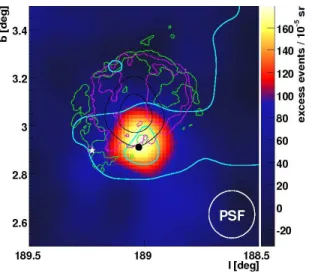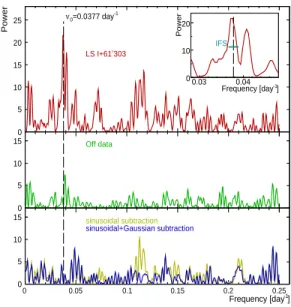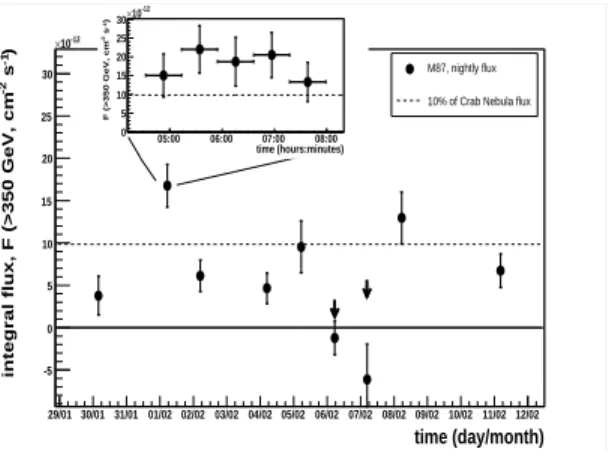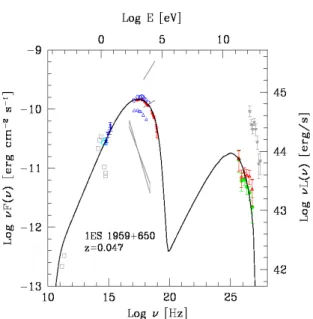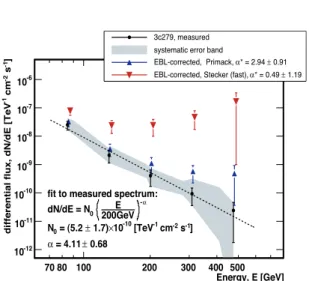A MAGIC view of the Very High Energy γ − ray Sky
P. Majumdar a (On behalf of the MAGIC Collaboration) Deutsches Elektronen Synchrotron,
Platanenallee 6, 15738 Zeuthen, Germany
a
Located at the Canary island of La Palma MAGIC is currently the largest single dish Cherenkov telescope operating since September 2004. Since then it has been delivering a wealth of exciting physics results from its observations in the Very High Energy (VHE) region of galactic and extragalactic sky. We present a review of the most recent experimental results obtained using MAGIC.
1. Introduction : The MAGIC Telescope The MAGIC telescope is located on the Ca- nary Island of La Palma (28.75 ◦ N, 17.86 ◦ W, at 2225 m a.s.l.). The telescope comprises of a 17 m diameter tessellated, parabolic mirror with a total surface of 234 m 2 , a light-weight space- frame made from carbon fiber-epoxy tubes, and a camera with 576 hemispherical photo-multiplier tubes (PMT) with enhanced quantum efficiency [1]. The field of view of the camera is 3.5 ◦ while the trigger area covers about 2.0 ◦ in diameter.
The fast PMT analog signals are routed via op- tical fibers to the DAQ-system electronics in the counting house 80 m away. The signals are digi- tized by 2 GHz FADC system [2]. MAGIC can ex- plore γ-rays at energies down to 50 GeV (trigger threshold, depending on the zenith angle), critical for the observation of high redshift VHE sources with steeply falling spectra. The MAGIC tele- scope parameters and performance are described in more detail in [3] [4]. The sensitivity of the telescope is estimated to be about 1.6% of the Crab nebula flux in 50 hours for a 5 σ detection.
The development of a trigger system, the so called SUM trigger, designed specially for pulsar ob- servations, enables MAGIC to to detect showers as low as 25 GeV, the lowest threshold achieved by any Cherenkov telescope till now. The en- ergy resolution of MAGIC is ∼ 25% above 200 GeV and angular resolution is ∼ 0.1 ◦ above 500 GeV. Simultaneous with MAGIC, optical obser-
vations are performed with the KVA telescope on La Palma, operated remotely from Tuorla Obser- vatory. The main instrument is a 60 cm (f/15) Cassegrain telescope equipped with a CCD capa- ble of polarimetric measurements. A 35 cm auxil- iary telescope (f/11) is mounted on the same RA axis. This telescope is used for BVRI CCD pho- tometry.
In this paper, we highlight the latest contri- butions of MAGIC to galactic and extragalactic astrophysics.
2. Galactic Observations
In the last years, MAGIC has discovered VHE emission from IC-443, the Crab pulsar and X-ray binary LSI + 61 303 and has detected an evidence of γ − ray emission from Cygnus X-1. It has also confirmed the γ − ray emission from several SNRs, Galactic Centre and the unidentified source TeV J2032+4130 and has provided strong upper limits to the pulsar and SNR PSR B1951+32/CTB80, X-ray binary Cygnus X-3 and a possible new class of γ− ray sources : Wolf-Rayet stars.
2.1. Shell Type Supernova Remnant : IC- 443
IC-443 is an assymmetric shell-type SNR at a
distance of 1.5 Kpc. It has been detected in ra-
dio, X-ray and γ− rays. The emission from the
X-ray pulsar CXOU J061705.3+222127 is not co-
incident with the high energy emission detected
by EGRET. MAGIC observed the region for 29
hours which resulted in a point-like excess of 5.7 σ signifcance (MAGIC J0616+225) centred around (α,δ) = (6 h 16 m 3 s , +22 ◦ 31
′48 ” ) [5]. The MAGIC emission appears displaced to the south of the centre of SNR shell and is correlated with dense molecular cloud and the location of maser emis- sion. The EGRET source is also centred in the shell of the supernova remnant. The observed VHE radiation may be explained as due to π 0 decay due to interactions of cosmic rays acceler- ated in IC-443 with the dense molecular cloud.
On the other hand an elctronic bremmstrahlung hypothesis for the origin of EGRET source is dif- ficult to reconcile with the fact that the radio syn- chrotron, X-rays and optical emission is concen- trated towards the rim while the EGRET source is located towards the centre.
Figure 1. Sky map of γ−ray candidate events (background subtracted) from the direction of MAGIC J0616+225. Overlaid are 12 CO emission contours, con- tours of 20 cm VLA radio data, X-ray contours and γ −ray from EGRET. The white star denotes the position of the pulsar CXOU J061705.3+222127. The black dor shows the position of 1720 MHz OH maser
2.2. X-ray Binary : LSI +61 303
The binary system LSI +61 303 consists of a compact object and a B0V main sequence star with a circumstellar disc. The best ephemerides are obtained from radio measurements which
= 53991.2 MJD0
= 54017.7 MJD0
= 54044.2 MJD0
= 54070.7 MJD0
Orbital phase
0 0.1 0.2 0.3 0.4 0.5 0.6 0.7 0.8 0.9 1
0 10 20
0 10 20
]
-1s
-2cm
-12F(E>400 GeV) [10
0 10 20
0 10 20
-5 0 5 10
Figure 2. VHE ( E > 400 GeV) gamma ray flux of LSI +61 303 as a function of orbital phase for 4 observed or- bital cycles (4 upper panels) and averaged over entire ob- servation time (lowermost panel) for C1 and C2. Vertical error bars include 1 σ statistical errors
shows a periodic radio signal from the source with
a period of T = 26.4960 days [6]. Further evidence
of periodic emission was found in X-rays [7] and
hints of variable emission in γ− rays from EGRET
measurements. Recently, MAGIC collaboration
announced the discovery of variable TeV emission
from the system [8], later confirmed also by the
VERITAS collaboration [9]. Following this dis-
covery, the MAGIC collaboration carried out a
deeper exposure of the object covering 4 different
orbital revolutions of the system. The total obser-
vational data amounted to about 166 hours ( 54
hours in first cycle and 112 hours in second cycle,
hereafter denoted by C1 and C2 ). A lightcurve
(LC) with nightly binning was extracted for both
C1 and C2 and folded with the orbital periods
of LSI +61 303. The resulting LC for each indi-
vidual orbit and averaged over all orbits is shown
in Figure 2. The figure clearly shows a high flux
between the phases 0.6 and 0.7 whereas no signif-
icant detection occurs at the periastron passage
(around 0.2 and 0.3). Another interesting fea-
ture appears in the last observed orbit around phase 0.85 where a significant signal of 4.5 σ is detected. This signal was not observed in any previous orbits and clearly points to the variable nature of the source. An interesting study of LS I +61 303 is to probe if the TeV emission is pe- riodic. We investigated the combined lightcurves of C1 and C2 using a binning of 15 mins and produced a Lomb Scargle [10] [11] periodogram scanning the frequency range 0.0023-0.25d − 1 . We found a significant peak near the orbital period as determined by radio measurements with a post trial chance probability of 2 × 10 − 7 [12] (see Fig- ure 3). This shows that the main emission dur- ing phase 0.6-0.7 is periodic in nature. We have also organised an extensive multiwavelength cam- paign involving radio (VLBA, e-EVN, MERLIN), X-ray(CHANDRA) and TeV(MAGIC) telescopes during October-November 2006. From these ob- servations, we can exclude the possible existence of large scale ( ∼ 100 mas) persistent radio-jets, while we found a possible hint of temporal corre- lation between X-ray and TeV emission and evi- dence of radio/TeV non-correlation [13].
2.3. Crab Nebula and Pulsar
The Crab Nebula is one of the best studied non-thermal objects in the sky and is a standard candle in VHE γ− ray astrophysics. The MAGIC telescope has observed the Crab Nebula in dif- ferent observation periods and has measured the spectrum down to 60 GeV. The steady flux fits to a power law above 400 GeV, consistent with pre- vious VHE measurements, while the slope devi- ates from a pure power law below 300 GeV. From the Spectral Energy Distribution (SED) of the source, we have also estimated the peak position, due to Inverse Compton process, at E=77 ± 47 GeV [14] . Although the observations support the synchrotron Self-Compton (SSC) model, other models involving bremmstrahlung and π 0 decay processes cannot be ruled out.
The central engine of the nebula is the Crab pulsar (PSR B0531+21). It is a highly mag- netised neutron star which has a rotational pe- riod of 33 ms. The mechanism of pulsed emis- sion is an open question in astrophysics. The EGRET experiment has detected pulsed emission
=0.0377 day
-1ν
0303 LS I+61
o-1
] Frequency [day
0.03 0.04
Power
0 10 20
IFS
Off data
sinusoidal subtraction sinusoidal+Gaussian subtraction
-1
] Frequency [day
0 0.05 0.1 0.15 0.2 0.25
Power
0 5 10 15 20 25
0 5 10 15
0 5 10 15
Figure 3. Lomb Scargle periodogram over the com- bined 2005 and 2006 campaigns of LSI +61 303 data (upper panel) and simultaneous background data (mid- dle panel). In the lower panel is shown the periodograms after subtraction of sinusoidal signal period (grey) and si- nusoidal+Gaussian waveform (black). Vertical dashed line corresponds to orbital frequency
from the pulsar upto energies of ∼ 10 GeV, how- ever, no statistically significant pulsations have been observed at higher energies, mainly due to the high energy thresholds of the previous gen- eration imaging telescopes. This also suggested that the pulsed spectra should terminate at ener- gies below 100 GeV. MAGIC, in recent months, has made a significant improvement in the trigger system which allows it to observe showers as low as 25 GeV. This effort has made possible the very first detection of pulsed emission at high energies with a ground based Cherenkov telescope. A total of 22 hours of observation of the Crab pulsar has yielded a signal at 6.4 σ in the same phase bin as that of the EGRET measurements and simultane- ously with the optical data taken with the central pixel of the MAGIC telescope [15] (see Figure 4).
With these observations, one has been able to de-
termine the cut-off energy of the spectrum ( ∼ 16
GeV for an exponential cutoff and 21 GeV for a
super-exponential case ). These results pose se-
rious questions to the commonly accepted polar
Figure 4. Light curve of Crab pulsar for E > 25 GeV corresponding to a χ 2 -Test for null hypothe- sis equivalent to a 6.4σ rejection. The grey bands correspond to the EGRET signal region P1 (φ=(- 0.06,0.04)) and P2 (φ=(0.32,0.43)) [15].
cap model of pulsed emission and may favour the competing outer gap model. Further observations with MAGIC and Fermi/LAT telescope will shed vital light on this aspect.
3. Extragalactic Observations
Except for the radio galaxy M87, all currently known VHE γ− ray emitters in the extragalactic sky are BL Lac objects [29]. Their two bumped spectral energy distribution (SED) are charac- terised by a second peak at very high energies.
Two basic models are proposed to explain the spectral features : in synchrotron self-Compton models, the same population of electrons respon- sible for synchrotron radio-to-X-rays emission is also responsible for γ-ray emission, through Compton up-scattering of the synchrotron pho- tons off their own parent electrons. In other models, electrons scatter ’external’ photons orig- inated outside the jet (External Compton (EC) models) [30]. In hadronic models, instead, inter- actions of a highly relativistic jet with ambient matter are the origin of high energy photons [31].
In this section, we report on the selected results on extragalctic sources from MAGIC.
3.1. Flare from M87 in February 2008 M87 is a giant elliptical radio galaxy of Fanaroff-Riley-I type. It lies in the Virgo clus- ter at a distance of 16 Mpc from us. It hosts in its core a supermassive black hole with a mass
of abbout 10 9 solar masses. The source is widely studied in all wavelengths revealing an extended jet from radio to X-rays with a rich structure which can be resolved owing to its proximity to us. It has been discovered as a TeV emitter by HEGRA collaboration [16] and later confirmed by H.E.S.S. [17] and VERITAS [18]. MAGIC has shared a regular monitoring of this source with H.E.S.S. and VERITAS. During one such campaign, MAGIC detected a a strong signal of flaring activity on February 1, 2008, triggerring SWIFT satellite and other IACTs. The flare reached a maximum value of 15% of the Crab neb- ula flux [19]. In addition, during a monitoring pe- riod of 13 days, the flux was found to be variable above 350 GeV on a timescale as short as 1 day at a significance of 5.6 σ (see Figure 5. This puts a restriction on the size of the emission region to be R ≤ ∆ t c δ = 2.6 × 10 15 cm and also suggests the core of M87 as the origin of TeV gamam rays.
The averaged differential energy spectrum of M 87 extends from ∼ 200 GeV to ∼ 10 TeV and can be well approximated by a power law with a photon index of -2.3 ± 0.11 stat ± 0.2 sys .
time (day/month)
29/01 30/01 31/01 01/02 02/02 03/02 04/02 05/02 06/02 07/02 08/02 09/02 10/02 11/02 12/02
)
-1s
-2integral flux, F (>350 GeV, cm
-50 5 10 15 20 25 30 10-12
×
M87, nightly flux 10% of Crab Nebula flux
time (hours:minutes)
05:00 06:00 07:00 08:00
)-1 s-2F (>350 GeV, cm
0 5 10 15 20 25 30 10-12
×
Figure 5. Nightly lightcurve of M87 measured from 2008 January 30 (MJD 54495) to 2008 February 11 (MJD 54507) for energy > 350 GeV The inlay shows the lightcurve in a 40 min time binning for the night with highest flux.
3.2. Detection of Blazars during optical outburts
MAGIC has been performing target of oppor-
tunity observations (ToO) triggered by high flux
states in optical band of known blazars or poten- tial VHE emitters. This strategy has been very successful as in the past 3 years 2 objects, namely Mkn180 [20] and 1ES1011+496 [21], have been discovered in VHE regime when triggered by op- tical outbursts. The most recent addition to this list has been S50716+714, a highly variable BL Lac object having its synchrotron peak in opti- cal band. It is the third Low Frequency BL Lac (LBL) to be discovered in VHE γ− rays and its redshift is estimated to be ∼ 0.31. In April 2008, KVA observed a high optical state and triggered MAGIC observations which resulted in a clear de- tection of a 6.8 σ signal in 2.6 hours, the flux above 400 GeV being ∼ 10 − 11 phcm − 2 s − 1 [22].
(detailed paper in preparation).
3.3. Multiwavelength Campaigns
For a deeper understanding of blazars, coor- dinated simultaneous multi-wavelength (MWL) observations are essential so that SEDs can be constructed over large energy ranges of 15 orders of magnitude. MAGIC has been participating in a number of MWL campaigns on known TeV blazars in the northern sky which involves X-ray instruments like Suzaku and Swift , optical and radio telescopes. Mkn421 was detected in such a campaign in April 2006 along with INTEGRAL, Suzaku and Swift which showed interesting intra- night variability during some nights.
Another campaign conducted on 1ES1959+65 showed the VHE flux at its all time low state while a relatively high flux was observed in opti- cal and X-rays [23]. The SED could be modeled assuming a one zone SSC model and the derived parameters were found to be very similar to the ones obtained during the observations of 2002.
(see Figure 6)
3.4. Discovery of VHE γ−rays from 3C279 VHE γ− rays are absorbed via interaction with low energy photons from the extragalactic back- ground light (EBL) if the involved photon ener- gies are higher than the electron-positron pair creation. The VHE γ− ray absorption, which is energy dependent and increases strongly with redshift, distorts the energy spectra of distant sources. Thus the observed spectra carry an im-
Figure 6. SED of 1ES 1959+650 as measured in 2006 to- gether with historical data. The average Suzaku spectrum (red) and Swift spectra are taken on May 24 and May 29.
Green points are the observed MAGIC spectrum, while the red points denote the spectrum after corrected for EBL absorption using the low-model of Kneiske et. al. [25]
print of EBL. Thus measurement of spectra can put strong constraints on EBL density in the op- tical to near infra-red band. MAGIC with its low energy threshold is particularly suited for such studies. In an observational campaign during the WEBT multiwavelength campaign on the famous and brightest EGRET AGN 3C279 (located at a redshift of 0.536), MAGIC discovered a flare from the source at very high energies on 23 rd February 2006 which yielded a significance of 5.77 σ after corrections for trials [24]. The overall probabil- ity of a zero-flux lightcurve can be rejected on 5.04 σ level. This is the first detection of VHE γ − rays from a new class of source, viz. Flat Spec- trum Radio Quasar (FSRQ). Simultaneous op- tical R-band observations by the Tuorla Obser- vatory Blazar Monitoring program revealed that during MAGIC observations, the source was in a high optical state without any indication of short term variability. The observed VHE spectrum can be described by a pure power law with a dif- ferential photon index of α = -4.1 ± 0.7 stat ± 0.2 sys
between 75 and 500 GeV (Figure 7) and is sensi-
tive to the EBL between 0.2 to 2 µm. Due to the
Energy, E [GeV]
70 80 100 200 300 400 500
]
-1s
-2c m
-1diffe rential fl ux, dN/d E [ TeV
10
-1210
-1110
-1010
-910
-810
-710
-6fit to measured spectrum:
-α
